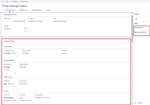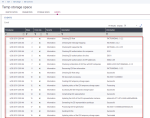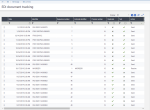EDI controls
Control screens are available to:
-
Obtain an overview of the existing setups in inquiry and modification mode.
See the: EDI setup query function.
-
View the list of processes in progress, the processing stages and potential errors.
See the: EDI temporary storage function.
-
Delete all or a part of the completed processes.
See the: EDI purge function.
-
View the history of the completed processes.
See the: EDI tracking documents function.
EDI setup query
EDI setup query (EDIQRY)
In this function, you can display the list of flows set up for each EDI partner between a Sage X3 site/company and a BP, mentioning their status, in other words, if they are active, valid, their version, etc.
You can manage this list by sorting out and selecting relevant data.
Two EDI cache synchronization actions are available. These technical actions are used to synchronize the Sage X3 and MongoDB databases: each single element of the EDI setup (message mapping, flow, etc.) is saved in the MongoDB database after having been assigned a unique identifier number (UUID).
These synchronization functions are typically used during the deployment of Sage X3. Indeed, there are no record in the MongoDB database yet. Therefore, the UUIDs corresponding to the flow setup elements need to be generated in the MongoDB database.
You can directly access the details of the setup and associations.
EDI temporary storage
EDI temporary storage (EDISTO)
This screen displays the list of in progress and completed documents. These documents are stored in a temporary storage space.
You can apply a filter and only display processes in the Receive or Send mode.
As a consequence, you can quickly view the main parameters defining each processing and check its status (Pending, In progress, Error, Terminated).
For failed processes, display the processing details in the Events section to view the stages that generated errors.
The listed documents can be deleted, when their status is 'Completed', for example.
To delete a document, click Delete from the Actions icon.
To mass delete a selection of documents, use the EDI purge action, which can be directly accessed in the action panel or the main menu.
From the Actions icon, click Display to get access to detailed information on the document.
The Parameters section shows the parameters involved in the processing: EDI Partner, Category, Protocol, Flow, Message Mapping:
You can directly access the display of the original document by clicking:
- Document for orders, invoices and deliveries
- Representation for delivery receipt notifications
For that purpose, it is necessary to meet the following conditions:
The processing cannot be in test mode.
- The processing must be: Completed
Once the source document is displayed, you can use EDI specific actions:
History
To view the history of exchanges for the generated EDI document, with the information details (date, partner, protocol, etc.).
See: EDI tracking documents.Outbound
To generate the EDI file directly from the original sales or purchase document (provided that the document has been validated and that you are granted the necessary functional authorizations).
Delivery notifications
They can be accessed from the deliveries, to view the delivery receipt notifications (only those that have not been deleted).
The Storage space section displays information about the identification of files managed by the EDI processing.
There are two types of files:
- The logical files correspond to the setup (e.g. flows, protocols, message mapping, sequential files and representations). They are stored in MongoDB with a unique identifier.
- Physical files are identified by a name and extension. They are stored in the directory specified at Protocol level under the name defined in the Sequential files definition.
The Events section recalls all stages of the processing, their statuses and the list of potential errors.
EDI purge
EDI Purge (EDIPURGE)
Use this screen to delete records from the EDI temporary storage space or files stored in MongoDB.
This screen is accessed from:
- The EDI temp storage space function
- The main menu
The purge of documents can also be done in batch mode, using the EDIPUR task.
In this screen, you can:
- Perform a selection based on criteria such as the lot number, creation date, EDI partner, document category
- Specify if files generated in test mode are considered or not
- Specify the statuses of the impacted documents: In progress, Completed, Error
Click Purge to launch the processing.
The purge results are listed in a log file displayed on the screen.
EDI document tracking
EDI tracking documents (EDITRKDOC)
This screen displays a list of the history of all documents exchanged through an EDI processing.
You can also access the history of a specific EDI document directly from the source document (see the EDI temporary storage space chapter).
Each record is created during the processing.
It contains the date, processing number, IDs and keys about the original document, and parameters such as the category, document type, status, etc.
You can thus view and check document duplicates for example.
For each document, you can view the details of the associated data.











